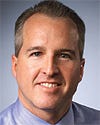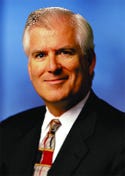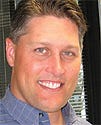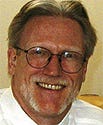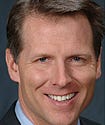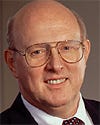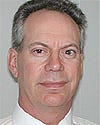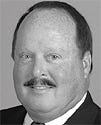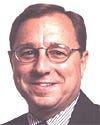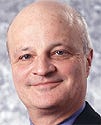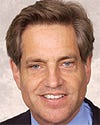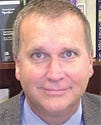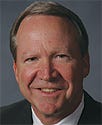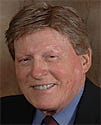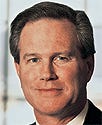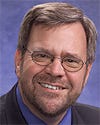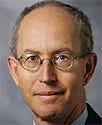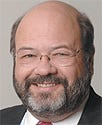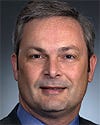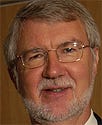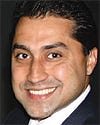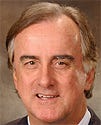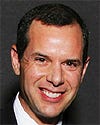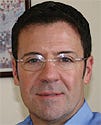50 Companies to Watch 1444
Originally Published MDDI June 2006 COVER STORY
June 1, 2006
COVER STORY
|
Abiomed Inc.
Danvers, MA
www.abiomed.com
Annual revenues:
$43.7 million (FY ended 3/06)
Key products: AbioCor implantable replacement heart, circulatory support system, biventricular support system, Impella cardiovascular support systems
Reason to watch: Abiomed's AbioCor, undergoing clinical trials, is the first totally implantable artificial organ of any kind, and it may be the most sophisticated medical device in existence. Other products are at the forefront of assisting the pumping function of the failing heart. Abiomed focuses on easy-to-implant devices, rather than more-complicated procedures that require the use of heart-lung machines. Recent acquisitions have broadened the firm's capabilities to include minimally invasive procedures and have given its ventricular-assist device line indications to treat almost every severe heart condition.
|
Miles White, |
Abbott
Abbott Park, IL
www.abbott.com
Annual revenues:
$4.1 billion (FY ended 12/05)
Key products: Stents, vessel closure systems, blood-screening and blood-analysis products, glucose monitors, immunoassay and clinical chemistry instruments, molecular diagnostics, point-of-care diagnostics, spinal implant devices
Reason to watch: Abbott, not Johnson & Johnson or Boston Scientific, may be the biggest winner in the Guidant Corp. acquisition. Abbott helped Boston Scientific finance its bid and in return received Guidant's stent business. This is a huge boost for Abbott Vascular, one of Abbott's many divisions involved with medical devices. A drug-eluting stent, ZoMaxx, was already in development, and with the Guidant technology in hand, Abbott could become a significant player in the lucrative field more quickly than expected. Abbott Vascular also boasts one of the few FDA-approved carotid artery stent systems, the Xact. With new data supporting the effectiveness of the procedure, the firm could benefit greatly from the technology. Abbott is also a leader in diabetes care, offering a number of glucose monitors for home and hospital use. A continuous glucose monitor is in development. In the diagnostics field, Abbott offers the AxSym Plus, the most successful immunoassay system, with more than 15,000 placements in 10,000 laboratories. The tests it can run include cancer, cardiovascular, drugs of abuse, fertility, pregnancy, and thyroid. Its Cell-Dyn hematology instruments are known for their swiftness and efficiency. And its Prism technology is one of the world's leading blood-screening systems, keeping blood banks safe from hepatitis and retroviruses. It also has a strong presence in point-of-care blood analysis. Abbott has become a major player in molecular diagnostics, the cutting edge of the diagnostics field. Its products detect subtle changes in genes and chromosomes, leading to earlier diagnosis and treatment of a variety of conditions. Abbott Spine is at the forefront of developing minimally invasive techniques in spinal surgery, offering a number of plates, screws, and fillers. Significantly, its 2004 acquisition of Spine Next gave it a place in nonfusion technology. The Wallis system is a dynamic stabilization device that treats early degenerative disease without resorting to fusion. It is available in Europe and undergoing a trial to support U.S. approval from FDA. Abbott also offers a number of devices for the veterinary market. It routinely receives workplace excellence accolades and in recent years has acquired a reputation for strong quality. Abbott's breadth and its involvement in so many crucial device markets give industry observers a great many reasons to keep an eye on it.
|
William Facteau, |
Acclarent Inc.
Menlo Park, CA
www.acclarent.com
Annual revenues: N/A (privately held)
Key products: Relieva balloon sinuplasty system
Reason to watch: Sinus surgery hadn't made any major progress during the past decade—until Acclarent came into the picture. Founded by a doctor who was suffering from chronic sinusitis, Acclarent turned a catheter concept used in cardiovascular procedures into a novel ear, nose, and throat application. The procedure employs a balloon catheter that inflates to restructure a blocked nasal passage. The sinuplasty system preserves the sinus lining while reestablishing normal sinus function and minimizing patient trauma. Acclarent's new approach could open the door for thousands of patients who have long avoided sinus surgery. In the long term, Acclarent is dedicated to developing innovative technologies throughout the field of otolaryngology.
|
Martin J. Emerson, |
American Medical Systems
Minnetonka, MN
www.americanmedicalsystems.com
Annual revenues:
$262 million (FY ended 12/05)
Key products: Urology and gynecology devices, erectile-restoration devices
Reason to watch: American Medical Systems has a corner on the market for erectile-restoration devices. The highly innovative company recently acquired the assets of BioControl Medical Ltd., an Israeli company that develops medical devices for the application of implantable electrical stimulation technology. AMS has acquired an exclusive license to use the technology in urology, gynecology, and other pelvic health applications. AMS plans to use the technology to finalize development of its Miniaturo system for treating urge incontinence and interstitial cystitis. The company also recently acquired Solarant Medical Inc., which develops minimally invasive therapies for women with stress urinary incontinence.
|
Thomas R. Trotter, president and CEO |
AngioScore Inc.
Fremont, CA
www.angioscore.com
Annual revenues: N/A (privately held)
Key products: Scoring balloon catheter
for interventional cardiology
Reason to watch: The company's AngioSculpt scoring balloon catheter is a unique, safe, and easy-to-use improvement
over existing balloon catheters. The angioplasty balloon is surrounded by a system of nitinol elements that score arterial lesions as the balloon expands. The device is targeted at both coronary and peripheral vascular interventions. Peripheral use markets for these catheter products are just opening up and appear to be very large. Founded in 2003, AngioScore is an early player in this market with an excellent product. The product has received FDA clearance for balloon dilation of lesions in infrapopliteal arteries. The company is planning a mid-2006 U.S. market launch.The product is already in limited distribution in the European Union.
|
Mike J. Wilcox, |
Aqueous Biomedical Inc.
Colorado Springs, CO
Annual revenues: N/A (privately held)
Key product: SAS glaucoma shunt
Reason to watch: The SAS glaucoma shunt, which is in clinical trials, allows surgeons to generate a structure that can be controlled and used to vent fluid from the anterior chamber of the eye and reduce pressure that causes blindness. The implantable device, installed in a glaucomatous eye, does not produce a scleral blister on the surface of the eye, which distinguishes it from all other products currently on the market. One of the most promising outlooks for the shunt is long-term treatment of pediatric glaucoma, because children rapidly develop tolerances to traditional medication options. Technologies that the company has developed have other applications, including drug-delivery devices and stimulating electrodes on implanted devices. The technology focuses on the basic science of extracellular matrix formation and how to get those matrices to perform specific functions.
|
Gregory Baldwin, CEO |
Baxa Corp.
Englewood, CO
www.baxa.com
Annual revenues: N/A (privately held)
Key products: Exacta-Mix 2400 automated compounder, Repeater pharmacy pump, fluid-handling devices
Reason to watch: Baxa's fluid-handling technology is used in hospitals and other critical-care settings, so its devices must be as safe, efficient, and practical as possible. Nearly 30 years ago, the company began by tackling the delivery of oral liquid medications with an oral dispenser that soon became an industry standard. This helped the company make its mark as the first to provide prepackaged inhalation medications in prefilled syringes. Baxa continues to improve on its industry firsts and expand its products by partnering with other companies and suppliers. Since the company's founding in 1975, its revenues have grown more than 20% each year. It anticipates that its increase in international sales well help it grow in the next five years.
|
Tony Bihl, |
Bayer
Tarrytown, NY (Diagnostics) and Elkhart, IN (Diabetes Care)
www.bayer.com
Annual revenues:
$2.746 billion (FY ended 12/05)
Key products: Diagnostics testing
products, blood glucose monitors
Reason to watch: Bayer is probably best known as a pharmaceutical company, but it has made significant contributions to the device world. It is one of the five giants in the diagnostics sector, known for strong quality, fast product approval times, and offerings of great value to critical- and emergency-care units. Its product offerings are diverse and often cutting edge. Bayer's diabetes care division was the first to introduce portable glucose monitors and strips and has been an innovator in the field ever since. Its latest line, Ascencia, offers alternate site testing and requires smaller blood samples. Given their histories, expect significant new products from these divisions in the coming years.
|
Yoh-Chie Lu, |
Biosensors International Group
Singapore
www.biosensors.com
Annual revenues:
$71 million (FY ended 3/05)
Key products: Axxion and BioMatrix drug-eluting stents, stent-delivery
systems, catheter systems
Reason to watch: Biosensors has a pair of innovative bioresorbable drug-eluting stent technologies and could become a major player in that extremely lucrative market. In both cases, no polymer remains in the body after elution is complete. Axxion is available in Asia and Europe, and U.S. introduction could come in 2008. BioMatrix, in clinical trials, is fully vertically integrated: Biosensors owns the patents for its stent design, drug, and bioresorbable polymer. And the company can achieve even further integration with its lines of delivery systems and catheters. This approach could give the firm an advantage over competitors that must pay licensing fees for various aspects of their systems.
|
Astro Teller, |
BodyMedia Inc.
Pittsburgh, PA
www.bodymedia.com
Annual revenues: N/A (privately held)
Key products: Wearable body monitors
Reason to watch: BodyMedia develops wearable body monitors that enable frequent and easy collection of patient data. It designs and builds accurate and convenient ways to collect, process, and present information about a person's health and behaviors outside of a clinical setting. Unlike most companies in this particular device space, BodyMedia's products are focused on preventing health problems. If used properly, they have the potential to save an astronomical amount of healthcare costs. They can monitor things like weight loss, diabetes management, and energy expenditure. The company's Healthwear weight loss system won a Medical Design Excellence Award in 2004. It has a multisensor design that can differentiate among various types of physical activity. The firm, backed by venture capital, has been growing about 50% per year and is on the verge of profitability.
|
James Tobin, |
Boston Scientific Corp.
Natick, MA
www.bostonscientific.com
Annual revenues: $6.3 billion (FY ended 12/05)
Key products: Taxus drug-eluting stent, cardiac rhythm
management devices, a wide variety of interventional cardiology products, neurostimulators
Reason to watch: There will be no device company watched more closely over the next year than Boston Scientific. The company just completed the largest deal in medical device industry history, buying Guidant Corp. for $27 billion. This will make it the number-two provider of cardiac rhythm management devices, an extremely lucrative market primarily served by only three firms. The company is already a leader in stents and other cardiology products. Hospitals, physicians, patients, Wall Street analysts, and other observers are waiting to see how the merged company will be integrated and what benefits might come from the expanded resources and product lines. (How it handles fallout from problems with Guidant's implantable cardioverter-defibrillators will be much watched, too.) Revenues for 2006 are expected to jump to more than $9 billion. Boston Scientific was already one of industry's greatest success stories of this decade. Since the U.S. launch of its Taxus drug-eluting stent in March 2004, its revenues have nearly doubled. Taxus became the largest-annual-grossing medical device in history, as it drastically reduced restenosis in stent patients and impressed doctors with its easy deliverability. Taxus, new versions of which are in development, was the crowning achievement in a history of pioneering minimally invasive cardiology procedures. Boston Scientific has also staked out a position in innovative neurological treatments with the 2004 acquisition of Advanced Bionics Corp. From its inception in 1979, Boston Scientific has been driven by a belief that less-invasive medicine improves patient care by reducing risk, trauma, and cost. That legacy is everywhere in the device industry today, and with the heavy investment in the product-development pipeline made possible by the success of Taxus, that legacy will continue to grow.
|
Michael Garippa, |
CardiacAssist Inc.
Pittsburgh, PA
www.cardiacassist.com
Annual revenues: N/A (privately held)
Key product: TandemHeart PTVA System
Reason to watch: CardiacAssist's TandemHeart PTVA System is the only FDA-approved percutaneous extracorporeal circulatory support system, and it has the potential to transform interventional cardiology. A miniature external blood pump, it rests on the thigh and pumps blood to and from a patient's heart using his or her own veins and arteries. Significant is how fast and efficiently it can help heart patients. The TandemHeart System can be implemented within 30 minutes and can circulate up to 5 L/min of blood to the patient. Attached percutaneously with a transseptal puncture via the femoral vein, it has been reported that it has been used to help patients survive heart attacks and high-risk procedures and helps them endure all kinds of cardiac interventions. A pediatric version is in development.
|
James M. Sweeny, |
CardioNet
San Diego, CA
www.cardionet.com
Annual revenues:
$31 million (FY ended 12/05)
Key products: wireless cardiac
telemetry products
Reason to watch: CardioNet is the first company to create a product that uses cell phone technology to conduct real-time monitoring. The value has been in taking the person's cardio activity through real-time wireless applications. Up until now the only alternative has been for the patient to be in the hospital. CardioNet began operations in 1999. The company provides integrated cardiac monitoring, wireless communications, GPS, and proprietary information management technologies. The CardioNet mobile outpatient telemetry system provides real-time ECG monitoring. It incorporates continuous analysis and response for patients. In 2002, CardioNet received FDA approval for its core monitoring technology.
|
Kevin Nickels, |
Celleration
Minneapolis, MN
www.celleration.com
Annual revenues: N/A (privately held)
Key products: MIST Therapy System
Reason to watch: Treating chronic ulcer wounds isn't a glamorous topic. Yet Celleration was established on the grounds of developing a unique wound-healing device to meet this critical patient need. Instead of applying dressing after dressing, clinicians can simply spray a sterile saline mist onto the hard-to-heal wound, without even touching the skin. The treatment takes minutes, and results can be seen within a few days. Included in the device's indications are patients suffering from diabetic foot ulcers. The company notes that more than 60% of lower limb amputations in the United States come from diabetic patients. The system could help reduce the number of amputations in these patients. Celleration is conducting a series of clinical trials to position the MIST system to be the standard of care for wound healing in healthcare settings.
|
John Bishop, CEO |
Cepheid
Sunnyvale, CA
www.cepheid.com
Annual revenues:
$80.4 million (FY ended 12/05)
Key products: SmartCycler and GeneXpert genetic analysis systems
Reason to watch: Genetic testing involves a number of complicated steps, including sample preparation, amplification, and detection. Cepheid uses microfluidic and microelectronic technologies to create easy-to-use systems that analyze complex biological samples. The company focuses on applications in which rapid genetic testing is important, such as the infectious disease, cancer, and biothreat testing markets. The SmartCycler and GeneXpert systems can perform a broad range of genetic tests that include identifying infectious organisms and evaluating at-risk populations for the early detection of disease. Physicians can also determine the stage of a disease, such as cancer, and assess which therapy might be most effective.
|
John L. Erb, |
CHF Solutions Inc.
Brooklyn Park, MN
www.chfsolutions.com
Annual revenues: N/A (privately held)
Key products: Aquadex FlexFlow fluid-removal system
Reason to watch: Founded in July 1999, CHF Solutions has reduced time and inefficiency in the area of fluid removal through its Aquadex system. The Aquadex FlexFlow fluid-removal system is a therapy used to treat fluid overload in heart failure patients. The product has FDA clearance and is sold to hospitals throughout the United States. Medical practitioners can specify the amount of fluid to be extracted from a patient's blood at a controlled rate. Peripheral or central venous access may be used to access patients' blood. The company recently completed a randomized clinical trial that was presented at the March 2006 American College of Cardiology meeting as a Late Breaking Clinical Trial. The large trial included patients from 28 hospital sites. It demonstrated significant improvement at a 90-day follow-up using the Aquadex therapy versus current standard of care for hospitalized heart failure patients. Among the findings, researchers reported 38% greater weight loss, a 43% reduction in patients rehospitalized for heart failure, and a 50% reduction in the total number of rehospitalizations. In addition, the study found a 62% reduction in days spent in the hospital for recurrence of heart failure and a 52% reduction in emergency department and unscheduled clinic visits. This is a significant improvement in patient care as well as a decrease in healthcare costs associated with heart failure. According to the company, there are more than 1 million heart failure patients admitted to U.S. hospitals per year, and 90% of those admissions are to treat fluid overload.
|
Robert Cummins, |
Cyberonics
Houston, TX
www.cyberonics.com
Annual revenues: $103.4 million (FY ended 4/05)
Key products: VNS therapy system
Reason to watch: Cyberonics endured a grueling process to get a revolutionary device that treats depression approved. Although the company faced resistance from FDA and patient advocacy groups from the start, it continued to stand by its controversial vagus nerve stimulation (VNS) product. The patience paid off, and now the company has the only device on the market for treating chronic or recurring treatment-resistant depression in adults 18 and older. However, even after product approval, Cyberonics took heat. Last year, the Senate Finance Committee launched an investigation into how FDA handled Cyberonics's PMA application to add the indication of treatment-resistant depression to the device. The investigation was spurred by the fact that FDA approved the device despite opposition from more than 20 agency staff members, including scientists and medical officers. The finance committee issued its staff report in February. The VNS therapy system is an implantable device that activates parts of the brain by sending intermittent signals to the left vagus nerve, located in the neck. It is the company's only product and was first approved in 1997 as an adjunct therapy for epilepsy. Cyberonics reports that more insurance companies are approving payment for the device and that CMS has increased reimbursement by 37% in the last three years. The company has strong ambitions. Its CEO, Robert Cummins, has stated that Cyberonics intends to become a dominant industry leader in neuromodulation as the field becomes the next multi-billion-dollar frontier for medical devices. The field has the potential to treat a wide range of indications. During the past decade, the number of patients diagnosed with major depressive disorder increased by 350%, and the number of people with treatment-resistant depression shot up nearly 700%. Neuromodulation therapies may also be able treat illnesses such as heart disease and obesity. Cyberonics is currently conducting investigational clinical trials to study VNS therapy as a treatment for anxiety disorders, Alzheimer's disease, bulimia, and chronic headaches or migraines. Despite its critics, neuromodulation is a hot field with tremendous growth prospects. Giants such as Boston Scientific Corp., Medtronic Inc., and St. Jude Medical Inc. have become players in recent years. The potential is there for Cyberonics to be grabbed by another behemoth—or become one itself.
|
Patrick Sullivan, |
Cytyc Corp.
Marlborough, MA
www.cytyc.com
Annual revenues:
$508 million (FY ended 12/05)
Key products: ThinPrep pap test, ThinPrep imaging system, MammoSite radiation therapy
system, NovaSure endometrial
ablation system
Reason to watch: Cytyc Corp. has made considerable strides in women's healthcare in the past decade and anticipates nearly doubling its financial success in the next couple of years. Ten years ago, it developed an innovative alternative to the conventional pap smear, called the ThinPrep pap test. Now, Cytyc touts this liquid-based cytology test as the most widely used method for cervical cancer screening in the United States. It's also the only FDA-approved liquid-based cytology test for the human papillomavirus. If the company's success continues at this rate, its revenues are predicted to reach $1 billion in 2008.
|
Michael Mussallem, chairman and CEO |
Edwards Lifesciences
Irvine, CA
www.edwards.com
Annual revenues:
$998 million (FY ended 12/05)
Key products: Tissue heart valves,
critical care monitors, peripheral stents
Reason to watch: Strong sales of the company's heart valve therapies are driving company growth. Edwards' Perimount Plus mitral heart valve is the only tissue valve designed to the specific requirements of the human mitral position. In the first quarter of 2006, the company saw double-digit growth in sales of its Perimount valves. The Perimount aortic heart valve is the first biomechanically engineered heart valve. Edwards expects continued strong performance in 2006 with increased sales of its Magna aortic valve and its ThermaFix anticalcification treatment. With 80% of sales coming from brands with leading global market positions, it has a strong hold in a lucrative market.
|
Frederic H. Moll, |
Hansen Medical
Mountain View, CA
www.hansenmedical.com
Annual revenues: N/A (privately held)
Key products: Hansen robotic catheter system and guide catheters
Reason to watch: The robotic catheter system uses computed catheter control technology to provide stable and predictable control of catheter movement within the heart and other organs for treatment of conditions and diseases, including heart arrhythmia. It provides fine guide catheter control in 3-D, allowing physicians to access hard-to-reach anatomy and to maintain stability during interventional procedures. Instinctive integration and interpreted motion logic help physicians direct catheter movement regardless of image orientation or perspective. The company used input from physicians to develop a system that enables operators to work comfortably and effectively while minimizing their exposure to radiation.
|
Christopher Begley, |
Hospira Inc.
Lake Forest, IL
www.hospira.com
Annual revenues: $2.63 billion (FY ended 12/05)
Key products: Medication management software, infusion pumps, intravenous sets, drug-delivery systems, vascular and cardiac catheters, angiography kits
Reason to watch: A spin-off of Abbott, Hospira is one of the largest manufacturers of hospital products in the United States. Its products range from prefilled syringes to drug-dose safety software that can be integrated into infusion pumps. Although hospitals are the company's primary customers, alternate-site clinics, home-healthcare providers, and long-term care centers also use the devices. Last year was Hospira's first full year as an independent company, and it remains determined to stay number one (or number two, in some cases) in its markets. During the last several months, Hospira has introduced three medication delivery systems, which included a wireless version of its MedNet safety software for three of its infusion systems. The MedNet software is the first pain management drug-delivery system that has a built-in bar code reader and is also compatible with prefilled, bar coded drug vials. Hospira's philosophy is rooted in patient and caregiver safety, and its products are a clear demonstration of this viewpoint. Its LifeShield products provide protection from needlestick injuries, and the medication management systems minimize dosage errors. And that's only the beginning. Hospira also seeks alliances and acquisitions to expand its product reach. Last year it acquired Physiometrix and launched the SEDLine brain function monitor, which observes the effects of anesthetic and sedation. In April, Hospira became the first infusion therapy manufacturer to have compatibility with InnerWireless Inc.'s in-building wireless system. The bridge between InnerWireless's medical-grade wireless utility and Hospira's drug management systems allows a hospital to securely transmit data from almost any place that a patient is receiving treatment in the center. Moving forward, Hospira is planning to increase its research and development investment and expand its global presence.
|
Doug Daniels, |
Hydrocision Inc.
Billerica, MA
www.hydrocision.com
Annual revenues: N/A (privately held)
Key products: SpineJet hydrosurgery system, SpineJetXL, SpineJet hydrodiscectomy system
Reason to watch: Hydrocision has positioned itself at the forefront of the rising hydrosurgical market. Hydrosurgery uses high-pressure water jets to apply an extremely thin stream of water to cut, ablate, and remove tissue and debris without damaging surrounding tissue. These water jets were first used in industrial cutting processes, but Hydrocision tailored the technology to meet the technical and sterile requirements of surgery. In 2004, the company sold its VersaJet technology to Smith & Nephew's wound management division for $5 million, a strong indication of its product value. Hydrodiscectomy could become the standard of care for patients as the company maintains its solid place in the hydrosurgical field.
|
John Shannon, |
Incisive Surgical Inc.
Plymouth, MN
www.insorb.com
Annual revenues: N/A (privately held)
Key products: Insorb 20 subcuticular skin stapler, Insorb 1 single-use
forceps
Reason to watch: Incisive Surgical forged a new approach to skin closure with its subcuticular skin stapler, the Insorb 20. It combines the cosmetic results of absorbable sutures with the rapid closure times of metal skin staplers. The staples it dispenses are made from bioabsorbable materials and become absorbed by the body after a few months. Physicians and patients alike have praised the product, which is used in colorectal, obstetrics and gynecology, vascular, cosmetic, and general surgery, and whose use is growing rapidly. The stapler received a Medical Design Excellence Award in 2005 and the Frost & Sullivan Wound Closure Product Innovation of the Year Award in 2006.
|
Jeffrey Martin, |
Innovative Neurotronics Inc.
Bethesda, MD
www.ininc.us
Annual revenues: N/A; product launch was March 2006
Key products: WalkAide System
Reason to Watch: Innovative Neurotronics operates in a unique sector that it pioneered. Called myo-orthotics, it lies somewhere between prosthetics and orthotics and encompasses technology that combines orthotics with electrical stimulation to restore muscle function. The company's first device, the WalkAide System, uses sensor technology to increase patient mobility by countering foot drop. A problem that affects one's ability to flex the ankle, foot drop causes patients to trip and lose their balance. Current treatment involves wearing a brace or finding the root of the problem, which could lead to surgery. Owned and operated by Hanger Orthopedic Group Inc. (Bethesda, MD), Innovative Neurotronics spent more than 10 years developing the WalkAide System, which was approved by FDA last September. Worn just below the knee, the device reestablishes communication between nerves and muscles via electrical signals, which triggers muscles to raise the foot. This alternative treatment not only helps patients walk normally, but it also increases strength and endurance and reduces the rate of injury. Innovative Neurotronics is recruiting patients for more clinical trials, the results of which could reveal additional information about the technology's effectiveness in treating patients. Considering the company created its own niche, it is sure to produce additional myo-orthotic products in the future.
|
M. Laine Mashburn, |
Ionics Medical Corp.
Ether, NC
Annual revenues: N/A (privately held)
Key products: Spinal interbody fusion device
Reason to watch: The company has developed a shock-absorbing, vertically expandable hybrid spinal device. The device has applications for interbody fusion, nucleus replacement, and dynamic stabilization. It has the potential to displace total disk replacement. An aging U.S. population will drive increased demand for spinal procedures. In 2006, the company will focus on completing the FDA approval process for the hybrid spinal device. Provided the device is approved, in 2007, the company will use independent sales agents to begin sales of the device. Sales are projected at $15 million in 2007 and projected to reach $75 million in 2010. The company has already developed a vertically expandable vertebral body replacement device, which was sold to another spine company in 2000.
|
Duane DeSisto, |
Insulet Corp.
Bedford, MA
www.myomnipod.com
Annual revenues: N/A (privately held)
Key products: OmniPod insulin management system
Reason to watch: The company's insulin management system addresses many of the current barriers to adoption of continuous subcutaneous insulin delivery for the patients with diabetes, healthcare professionals, and health insurance organizations. The system is a single-use, three-day wearable drug-delivery device. Insulet introduced a number of features that had previously been unavailable and that may have prevented more-widespread use. The system includes a handheld Personal Diabetes Manager that communicates wirelessly to the OmniPod. It is lightweight, small, and free of tubing, allowing it to be worn discreetly. In addition, the lack of tubing eliminates daily disconnection that many patients perform for activities such as showering and getting dressed.
|
Joe Kaufman, |
Kensey Nash Corp.
Exton, PA
www.kenseynash.com
Annual revenues:
$61.4 million (FY ended 6/05)
Key products: Angio-Seal vascular closure device, TriActiv embolic protection system, QuickCat extraction catheter
Reason to watch: Kensey Nash has a tremendous record of product development, sometimes commercializing the end results and sometimes licensing them out to partners. The Angio-Seal, licensed to St. Jude Medical Inc., is a top puncture-closure device and one of the most successful interventional cardiology products. The TriActiv system captures and extracts debris and shows promise for use with carotid artery stenting. The company also has a biomaterials business specializing in development of bioresorbable implants. Of note here is its collaboration with Orthovita Inc., the Vitoss scaffold foam platform, a bone-void filler with unique properties.
|
James Ham, |
Kinetikos Medical Inc.
Carlsbad, CA
www.visitkmi.com
Annual revenues: N/A (privately held)
Key products: Orthopedic devices used in small bone surgery
Reason to watch: Despite the company's small size, Kinetikos Medical still manages to treat patients from almost head to toe. While most orthopedic companies are pouring their investments into treatments for large bones and joint replacement, this company of only 40 employees focuses solely on devices in the small bone segment. Using input from surgeons, Kinetikos Medical addresses this orthopedic niche within a fast product development timeline. In the last five years, the company released seven products, and it currently has three more in development. Its implantable devices fuse carpal bones; correct flat foot; and treat fractures, other trauma, and arthritis. The company is also moving into bioabsorbable materials for orthopedic applications. These products include prosthetics and trauma devices for the extremities.
|
Laurence J. Steudle, |
MediPhysics Pain Centers of America Inc.
Lake Forest, CA
www.mediphysics.org
Annual revenues: N/A (privately held)
Key products: MediPhysics pain treatment system (MPTS)
Reason to watch: MediPhysics was founded in June 2002 to commercialize a noninvasive technology that uses electromagnetic signals to treat pain. The company's first product, the MPTS, treats patients who receive only limited help from current medical options. The device has been cleared by FDA but is not yet on the market. The MPTS is a proprietary medical device that treats pain by applying a focused electrical signal through two probes that are placed against the skin. The technology has demonstrated its ability to reduce or eliminate pain for patients suffering from a wide variety of types of pain, including arthritis and back pain. In clinical trials, the system has reduced pain in patients who have tried other treatments with no success.
|
Art Collins, |
Medtronic Inc.
Fridley, MN
www.medtronic.com
Annual revenues: $10.1 billion (FY ended 4/05)
Key products: Cardiac rhythm management devices, insulin pumps, glucose monitors, stents and other vascular products, neurostimulation, spine products,
cardiac surgery products
Reason to watch: When MD&DI was first launched in 1979, everyone had to watch Medtronic because it was the only sizable medical device company in the United States. The level of interest remains, but for different reasons. The breadth and depth of its product lines are virtually unmatched, and it is at or near the top of almost every highly lucrative medical device market. Its size, diversity of interests, and vaunted nose for growth make it a player for almost any promising company looking to be acquired. It is probably best known as the world leader in one of the most vital and highest-growing sectors, cardiac rhythm management, which includes pacemakers and implantable cardioverter-defibrillators. It recently achieved a significant breakthrough in diabetes management with the introduction of the first insulin pump with real-time glucose monitoring. It has won several Medical Design Excellence Awards and has been named to Fortune magazine's list of “America's Most Admired Companies” for nine straight years. But perhaps Medtronic's significance can be summed up with this: If there were no Medtronic, the Twin Cities would never have become Medical Alley.
|
David Macdonald, |
Nanomix
Emeryville, CA
www.nano.com
Annual revenues: N/A (privately held)
Key products: Nanoelectronic sensor monitoring devices
Reason to watch: Nanomix is a nanotechnology device company. Founded in 1997, the company has developed a portfolio of handheld sensors based on its Sensation detection platform. The company's nanoelectronic devices use a network of carbon nanotube elements combined with proprietary chemistries to detect a broad range of chemical and biological molecules. Demand for high-value detection devices is being fueled by an aging population. Nanomix is aggressively pursuing commercialization of several biomedical applications. It was the first company to bring a nanoelectronic detection device to market, and it is currently in the late stages of developing monitors for respiratory applications, including sleep apnea monitoring, asthma monitoring, and metabolic testing devices.
|
Robert B. Chess, |
Nektar Therapeutics
San Carlos, CA
www.nektar.com
Annual revenues:
$126.3 million (FY ended 12/05)
Key products: Exubra insulin inhaler, Aeroneb Go micropump nebulizer, Aeroneb Professional nebulizer system, Aeroneb Lab micropump nebulizer
Reason to watch: Nektar Therapeutics is bringing a new approach to drug-delivery systems. The Exubra system is the first product to use the lung as a route for delivering systemic medicines. Along with the FDA-approved inhaled insulin product, a capsule-spinning antibiotics inhaler is currently in clinical trials. In addition, the company is developing an inhaled amphotericin B product for preventing fatal pulmonary fungal infections in immunosuppressed patients. Nektar's nebulizers use micropump technology to produce a fine mist of precisely defined particle sizes that can be tailored for specific applications.
|
Debra Reisenthel, |
Novasys Medical Inc.
Newark, CA
www.novasysmedical.com
Annual revenues: N/A (privately held)
Key products: Renessa system
Reason to watch: Often an awkward subject for women, stress urinary incontinence affects millions in the United States. Women suffer from urinary incontinence twice as much as men, and Novasys Medical wants to provide them with a nonsurgical alternative. The company developed a 20-minute outpatient treatment that uses radio-frequency energy to create low-temperature heat, which then treats tissue targets within the lower urinary tract. No incisions are made, and as the patient heals, the treated tissue is firmer, which increases resistance to involuntary leakage. The Renessa system is a unique and minimally invasive procedure that allows women to return to normal activities within the same day of being treated. Novasys Medical is also currently conducting new clinical studies on the system.
|
Alexis V. Lukianov, |
NuVasive Inc.
San Diego, CA
www.nuvasive.com
Annual revenues:
$61.8 million (FY ended 12/05)
Key products: Maximum Access Surgery (MAS) platform
Reason to watch: NuVasive's MAS platform is based on a technology that improves traditional minimally invasive procedures that many surgeons have found unfamiliar and awkward to perform. NuVasive offers products that enable surgeons to approach the spine laterally and that use nerve-monitoring technology. The process creates a customizable surgical exposure, or maximum access, for implant placement while minimizing tissue disruption. The MAS platform's surgical procedures are performed using familiar instruments and specialized implants, minimizing the learning curve. The technology offers dramatically reduced procedure time, substantially less blood loss, and reduced hospital stays.
|
Joseph A. Popper, |
Popper & Sons Inc.
New Hyde Park, NY
www.popperandsons.com
Annual revenues:
$11 million (FY ended 12/05)
Key products: Reusable hypodermic products
Reason to watch: The U.S. manufacturer supplies a range of reusable and specialty hypodermic products in a highly competitive market with heavyweights such as BD Medical. Founded in 1922, the company is still family owned and operated. Although the reusable instrument industry has seen declines, Popper has continued to grow through investment in technology, enabling the company to control costs. The company has focused on maintaining a highly skilled workforce. It shuns the term reusable devices in favor of a more-detailed description that encompasses specialty manufacturing for biomedical applications requiring high precision. The company manufactures 90% of its products in the United States.
|
Brian K. Hutchinson, |
Regeneration Technologies Inc.
Alachua, FL
www.rtix.com
Annual revenues:
$75.2 million (FY ended 12/05)
Key products: Spinal allografts, general orthopedic allografts, cardiovascular allografts, bone graft substitutes,
sterling biological matrix bovine
medical devices
Reason to watch: Regeneration Technologies is the first company to offer precision-tooled bone implants for spinal surgeries. The company preshapes allograft and xenograft tissue to specifications for transplantation. Surgeons implant the allografts to repair a variety of bone and other tissue defects, including spinal vertebrae repair, musculoskeletal reconstruction, fracture repair, periodontal repair, and heart valve disorders. The company's BioCleanse tissue sterilization process eliminates viruses, bacteria, fungi, and spores from tissue without affecting its integrity.
|
Anthony Viscogliosi, |
Small Bone Innovations Inc.
New York, NY
www.totalsmallbone.com
Annual revenues: N/A (privately held)
Key products: Artelon Spacer CMC-I, Total Wrist, Universal Hand System, RingFIX
Reason to watch: Small Bone Innovations is going against the grain in its determination to become a market leader in the small bone and joint device sector. The two-year-old company has already acquired four companies and two global licenses, and it offers 42 products. Its 2005 revenue was 35% higher than the combined 2004 revenue of the four companies that it acquired. By specializing in products that replace, repair, or restore function in small bones and joints, the company aims to draw more attention to an orthopedic market segment that is in position for strong growth. Although most of its products currently treat the upper extremities, the company is assessing future product opportunities that focus on the lower extremities.
|
Christopher O'Donnell, |
Smith & Nephew Inc.
London, UK
www.smith-nephew.com
Annual revenues:
$2.55 billion (FY ended 12/05)
Key products: Orthopedics, wound management products, and arthroscopic technologies
Reason to watch: For the past six years, Smith & Nephew has been the fastest-growing orthopedic company in the world. This year the company launched three orthopedic products, including the Journey anatomical knee system, which is the first artificial knee system to restore normal knee function. In May 2006, it received FDA approval for its Birmingham hip resurfacing system, the first hip-resurfacing system in the United States. The company makes its orthopedic implants with a proprietary bearing material, called Oxinium, that is supposed to reduce the amount of wear on an implant. This makes the implants more appropriate for younger patients.
|
John G. Schulte, |
Spectranetics
Colorado Springs, CO
www.spectranetics.com
Annual revenues:
$43.2 million (FY ended 12/05)
Key products: Excimer lasers and
related catheters
Reason to watch: Spectranetics develops, manufactures, and markets its ultraviolet excimer laser technology for multiple cardiovascular procedures to physicians and hospitals worldwide. This technology safely and effectively removes arterial blockages and ablates the scar tissue holding problematic pacemaker and ICD cardiac leads in place. Spectranetics advances its technology through clinical research and development. The company has received FDA approval for 15 distinctive laser catheters for specific procedural applications. Its excimer laser technology systems have been adapted to treat refractory total occlusions common in critical limb ischemia, a condition that is most commonly treated with amputation.
|
Bruce Burgess, |
TheraFuse Inc.
Carlsbad, CA
www.therafuse.com
Annual revenues: N/A (privately held)
Key products: Flow sensors for infusion pumps
Reason to watch: TheraFuse has developed an optical flow sensor capable of measuring fluid flow with very high accuracy. The technology uses a pair of miniature lasers to detect flow in a small tube. This tube may be removable from the durable sensor and integrated into a fluid delivery line as a disposable product. Closed-loop flow control of any fluid movement force allows accuracy and precision. Small, low-cost, and durable pumps use disposable IV sets with closed-loop flow-control performance integrated into the set. The flow sensor also replaces pressure transducers and air-in-line detectors. Precision fluid-flow measurement has been driven recently by the onset of small, MEMS-enabled biotechnology devices. The company is also studying subcutaneous delivery and renal applications.
|
John Bottjer, |
3Gen LLC
Dana Point, CA
www.dermlite.com
Annual revenues: N/A (privately held)
Key products: DermLite skin cancer detection device
Reason to watch: In just five years, 3Gen LLC introduced a full line of devices that perform a relatively new and promising method of skin cancer detection. Called DermLite, the pocket-sized and inexpensive instruments are used for dermoscopy, a surface microscopy technique that screens skin lesions better than the naked eye alone. Looking ahead, 3Gen is shifting its emphasis to viewing products digitally. It's making product changes that will allow doctors to record digital images and then monitor the changes in skin lesions over time. The company already has a handheld device that can attach to a compact Sony camera. In the future, it plans to offer an integrated device that can view and record an image. The continuous evolution of 3Gen's products could play an important role in spotting skin cancer as early as possible.
|
Gregory Hines, |
Tm Bioscience Corp.
Toronto, ON, Canada
www.tmbioscience.com
Annual revenues:
$6.87 million (FY ended 12/05)
Key products: Tag-It cystic fibrosis kit
Reason to watch: Tm Bioscience has experienced significant growth in the past few years and nearly doubled its revenue in 2005. The Canadian company develops tests in a rising DNA-based diagnostics market that the company projects will reach $10 billion by 2010. Now it has identified its future in three market segments—human genetic diagnostics, pharmacogenetic diagnostics, and infectious diseases diagnostics—and it is striving to move DNA testing into mainstream healthcare. In May 2005, it received FDA approval for the first test to aid in cystic fibrosis detection. The breakthrough product analyzes DNA to find genetic variations that indicate cystic fibrosis. Tm Bioscience also plans on submitting a test for 510(k) clearance that identifies mutations in two specific genes that could affect the activity and metabolism of the drug warfarin.
|
Guban Kahn, CEO and chair |
US Endoscopy
Mentor, OH
www.usendoscopy.com
Annual revenues: N/A (privately held)
Key products: Endoscopic systems
Reason to watch: Since 1991, US Endoscopy has been serving the U.S. and international gastrointestinal endoscopy markets. The company provides proprietary devices for efficient endoscopic accessories for the GI clinician, including a polyp, foreign body, and food bolus retrieval system; airway protection during retrieval; and capsule endoscope delivery device. Its newest product is a polyp trap for endoscopic collection. A significant and growing proportion of sales are of proprietary endoscopic devices created by the company's new-product development group with the guidance and direction of luminary physicians and nurses worldwide. US Endoscopy employs trained groups of engineers to travel to hospitals and clinics around the world to observe endoscopy teams in action and ways to enhance current technology.
|
David Elsley, |
Vasogen Inc.
Toronto, ON, Canada
www.vasogen.com
Annual revenues:
None (firm is in development stage)
Key products: Celacade treatment for chronic inflammation
Reason to watch: Vasogen has a unique approach to cardiovascular and neurological disease that has the potential to have a huge effect on this market. It is developing devices and drugs that target the chronic inflammation that underlies such diseases. Its lead product, Celacade, is in the final stage of a pivotal trial. In Phase II studies, this antiinflammatory treatment strategy demonstrated an effect on a number of key clinical end points associated with cardiovascular disease. Use of Celacade has also been shown to reduce systemic inflammation in a broad range of preclinical models of inflammatory disease by up-regulating the production of anti-inflammatory cytokines and decreasing the production of proinflammatory cytokines.
|
Randy Thurman, |
Viasys Healthcare
Conshohocken, PA
www.viasyshealthcare.com
Annual revenues:
$510 million (FY ended 12/05)
Key products: Cortrak feeding tube placement system, respiratory diagnostic products, ventilators, monitoring equipment, orthopedic products
Reason to watch: Viasys was born in 2001 with the combining of more than 20 innovative device companies. As a result, the diversity of its products and expertise is broad and deep. Its products assist physicians in the diagnosis and treatment of cardiopulmonary, digestive, neurological, respiratory, and vascular disorders. It also has a clinical services division that provides data acquisition and monitoring services to clinicians and researchers. In the past four years, the firm has made 11 acquisitions, and its revenues grew 30% in 2005. One of its products introduced last year, the Cortrak feeding tube placement system, won a 2006 Medical Design Excellence Award.
|
Jay D. Miller, |
Vital Images Inc.
Plymouth, MN
www.vitalimages.com
Annual revenues:
$51.7 million (FY ended 12/05)
Key products: Vitrea 2, ViTAL Connect
Reason to watch: Vital Images develops visualization software that enables physicians to screen, diagnose, and plan patient treatments. The images generated on the software also serve as a substitute for invasive exploratory surgery. The company built on its main product, Vitrea 2, by creating customized options for the software that focus on specific parts of the body. The options, a couple of which were developed through teaming up with other companies, include different types of computed tomography tools for assessing heart function, blood flow in the brain, and locating polyps in the colon. The firm's partnerships with other companies have also proved beneficial. Its distribution agreement with Toshiba Medical Systems brought the company almost half of its 2005 revenue and provides Vital Images with most of its overseas sales.
|
Jal Jassawalla, |
World Heart Corp.
Oakland, CA
www.worldheart.com
Annual revenues:
$11.7 million (FY ended 12/05)
Key products: Novacor and Novacor II LVAS, WorldHeart rotary VAD
Reason to watch: World Heart has cutting-edge mechanical circulatory support technology. It is the only company with both next-generation pulsatile and rotary pumps in development. Pulsatile pumps provide functional replacement for the left ventricle, and rotary pumps provide partial support. The WorldHeart rotary ventricular assist device is the only bearingless, fully magnetically levitated implantable centrifugal rotary pump in clinical trials. The Novacor left ventricular assist system is self-regulating, automatically adjusting its beat rate and stroke volume in response to the recipient's changing circulatory requirements. The Novacor II, in animal trials, can be implemented without having to perforate the skin, which could reduce the risk of complications.
|
Predrag Sukovic, |
Xoran Technologies
Ann Arbor, MI
www.xorantech.com
Annual revenues: N/A (privately held)
Key products: MiniCAT for ENT
Reason to watch: Xoran Technologies has created a revolutionary compact CT scanner for sinuses and ears that is specifically designed to be used by ear, nose, and throat (ENT) physicians at the patients' point of care. Unlike large full-body CT scanners, the company's MiniCAT for ENT allows patients to sit comfortably upright in an open, patient-friendly design. This is a significant feature, because many patients complain of feeling claustrophobic in traditional CAT scanners. Adult scans take about 600 pictures in a 360° rotation around the head in only 40 seconds. Children's scans take 20 seconds, and the scanner has a significantly lower radiation dose than full-body scanners. Doctors get instant, high-quality images on a computer monitor, allowing them to diagnose problems and begin treatment as quickly as possible.
|
Peter von Dyck, |
Zassi Medical Evolutions
Fenandina Beach, FL
www.zassimedical.com
Annual revenues: N/A (privately held)
Key products: Zassi bowel
management system, Zassi continent ostomy port
Reason to watch: Zassi has pioneered technologies for the gastrointestinal market and has a knack for coming up with solutions of true utility and value. The Zassi bowel management system, which won a Medical Design Excellence Award in 2004, is an indwelling fecal catheter system that disposes of the fecal matter of bedridden and immobile patients in a closed system. This keeps feces off the patient's skin and bed linens. If pathogens are kept out of the healthcare environment, skin breakdown and infections could be greatly reduced, saving time and minimizing patient discomfort. Extensions of the product line are planned. The Zassi continent ostomy port, in development, is expected to free patients with ostomies from constant attachment to an ostomy pouch.
|
Greg Casciaro, |
Xtent Inc.
Menlo Park, CA
www.xtentinc.com
Annual revenues: N/A (privately held)
Key products: Drug-eluting stent systems
Reason to watch: Xtent has used innovative thinking to make drug-eluting stents designed for the toughest-to-treat patients with coronary artery disease, such as those with complex, multivessel, and multilesion vascular diseases. This is the largest and fastest-growing segment of the extremely lucrative market. The Xtent system allows cardiologists to customize stent length in situ; that enables them to fit the stent to exact lesion length, which may greatly increase the accuracy of the treatment. It may allow physicians to treat multiple lesions with a single device, avoiding gaps and overlaps and potentially reducing procedure time. Improving accuracy of treatment and minimizing catheter exchanges may decrease complications and errors. A physician could complete the procedure more quickly, using less fluoroscopy and contrast media, which could ultimately reduce overall procedural costs. The Xtent system's modular interdigitating design makes it flexible, allowing the stent to conform to the natural vessel shape as the heart beats, which is especially important in treating long lesions. And its coating is a fully bioresorbable polymer carrier. The firm believes its technology could catch on for single-lesion patients as well. It may also have potential in peripheral artery disease. The stent's first clinical trial has been completed, and a second, expanded one is under way, with multiple centers in Europe enrolling patients. If all goes well, the firm expects to introduce the product in Europe in 2007 and in the United States in 2009. The drug-eluting stent market today is dominated by large companies. But a number of small companies—Xtent Inc., Biosensors Ltd., and Conor Medsystems—are making waves. The interventional cardiology field has always been quick to embrace innovations, and as a result, market leadership is never static. So there is no reason to think that a small company like Xtent couldn't rise to the top—or be acquired on its way there.
Copyright ©2006 Medical Device & Diagnostic Industry
About the Author(s)
You May Also Like
